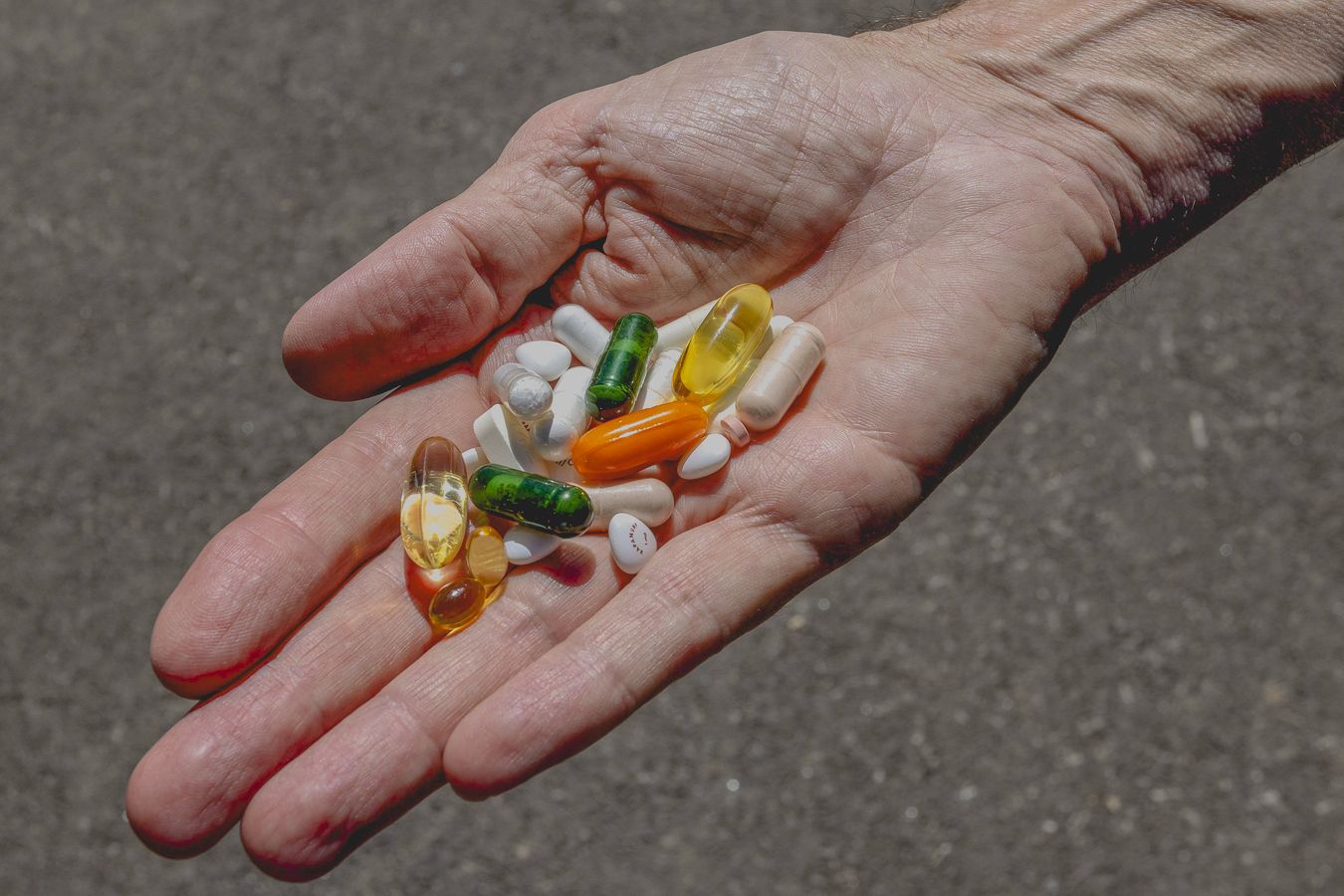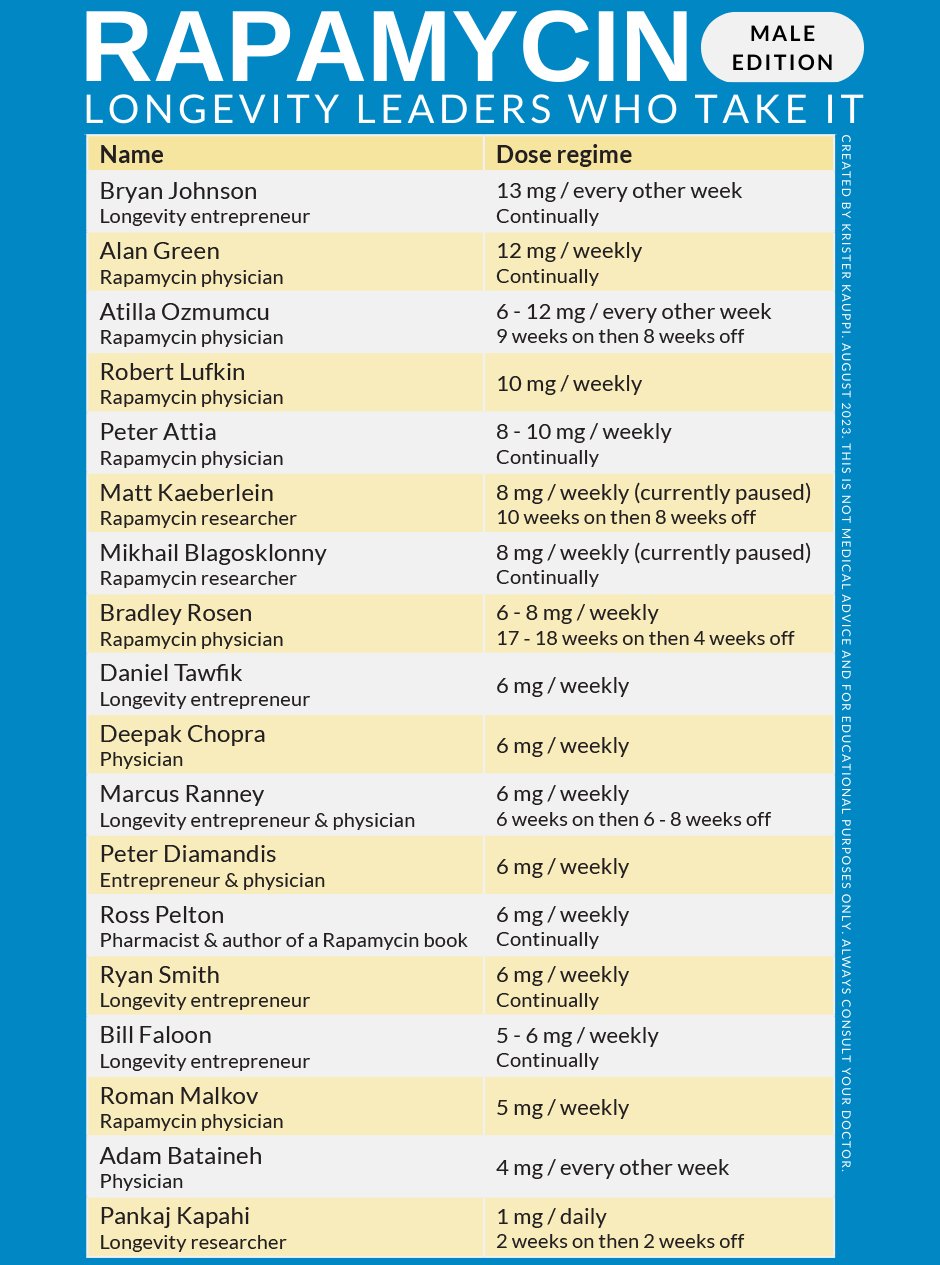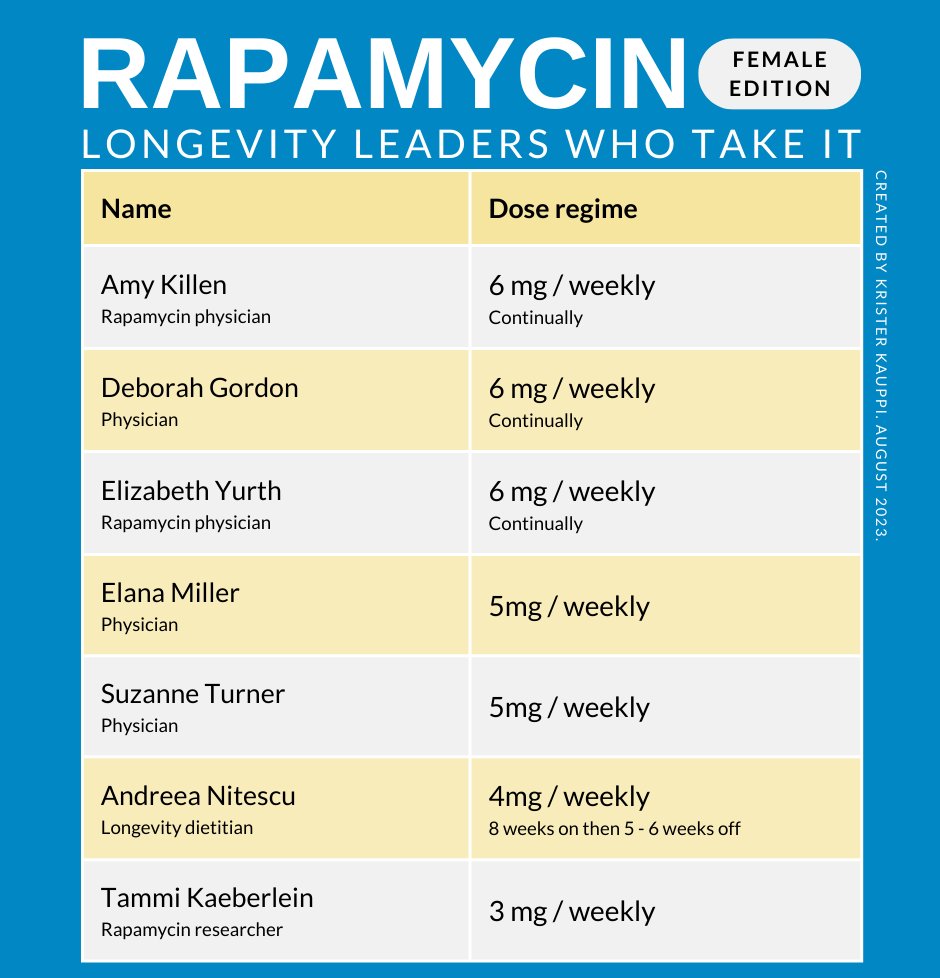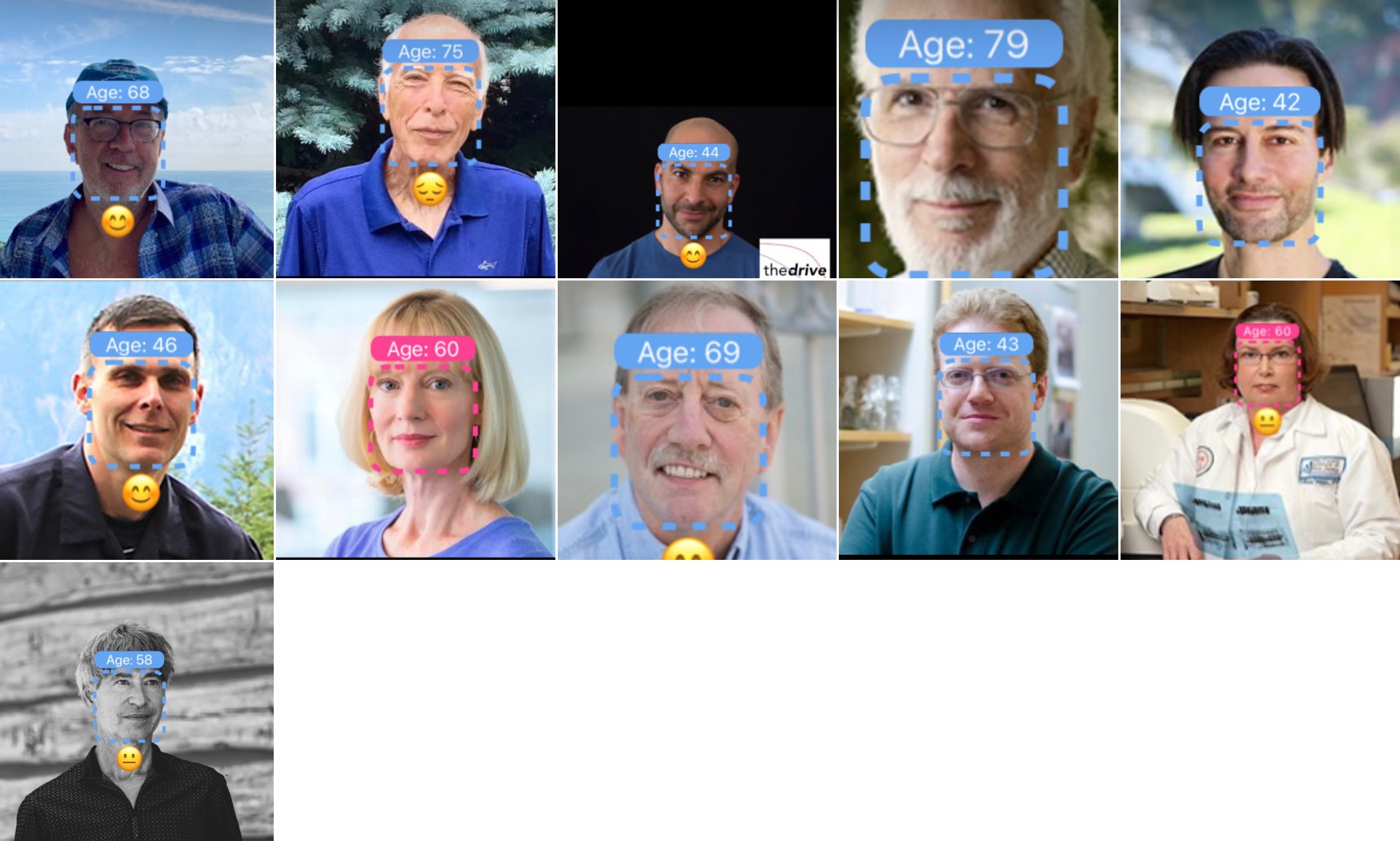Yes - and if side effects ever increase to a point where you don’t want to tolerate them any more, or you believe that your blood test results are not going in the right direction for a period of time, you can always stop or pause the use of rapamycin.
And unfortunately, it is very certain what will happen if we do not take active steps to forestall aging. I would rather waste money on some thing that did nothing, or even some thing that may have been detrimental in retrospect. The risk reward ratio for me is decidedly in favor of rapamycin. That said, we should be respectful of this drug and what we do not know. Joan Mannick understands rapamycin far better than I ever will.
17 posts were merged into an existing topic: PEARL / AgelessRX Rapamycin Trial Participant Feedback - So Far
In his personal life, Robert Nelsen, 60 years old, downs a daily cocktail of almost a dozen different drugs, including rapamycin, metformin, taurine and nicotinamide mononucleotide, all of which he says help prevent illness and promote longevity
The investment firm Robert Nelsen co-founded in 1986, Arch Venture Partners, has racked up billions in profits from early stakes in companies developing methods to detect and treat cancer and other diseases.
In his personal life, Nelsen, 60 years old, downs a daily cocktail of almost a dozen different drugs, including rapamycin, metformin, taurine and nicotinamide mononucleotide, all of which he says help prevent illness and promote longevity. Nelsen has a full-body MRI every six months, sees a dermatologist every three months and has annual blood tests to detect cancer. At his home in the Rocky Mountains, he works out in an “electric suit” that he says emits low-frequency impulses to build muscle and improve health.
“I know I will get cancer, I just want to catch it early,” says Nelsen, who says an MRI several years ago has already identified thyroid cancer at an early stage. He has seen family members die of the disease.
“Bob has a big fear of death,” says his wife, Ellyn Hennecke.

Nelsen shows some of the medications he takes in his efforts to prevent illness and promote longevity. At right, the ‘electric suit’ that he uses for workouts.NATALIE BEHRING FOR THE WALL STREET JOURNAL
Nelsen’s latest and largest investment—several hundred million dollars, he says—is in a company attempting something even more ambitious than aiding health and longevity. Altos Labs, based in the San Francisco Bay Area, San Diego, and Cambridge, U.K., is working on ways to rejuvenate cells to eliminate disease—an approach called epigenetic reprogramming. Nelsen and Altos’s founders believe they can turn the clock back on aging cells to restore functions characteristic of younger cells.
Arch is the largest institutional investor in Altos, which already has $3 billion of committed investments, likely making it the biotech industry’s best-funded startup on record.
Nelsen is characteristically unrestrained when discussing Altos’s prospects.
“Epigenetic reprogramming is the biggest thing in healthcare in 100 years. Or ever,” he says. “We will clearly live much healthier and longer lives if this works.”
That’s a huge if. Cellular rejuvenation has yet to be proven effective as a treatment. So far, the only data Altos and others in the field have produced is in mice, suggesting they are a long way from rolling out any products. Skeptics doubt cells can be reprogrammed to ward off age-related illnesses.
Nelsen realizes Altos faces imposing obstacles.
“The big question is, will this work in humans,” Nelsen acknowledges. “At first blush, it seems too good to be true.”
Nelsen favors designer jeans and black T-shirts, looking more like an upscale bike messenger than a deep-pocketed investor. He doesn’t hold a medical degree and never worked in a lab.
A native of Walla Walla, Wa., Nelsen studied biology and economics at the University of Puget Sound before getting an M.B.A. at the University of Chicago. His approach to building Altos is the same as with past investments: Identify leading scientists with ambitious ideas and back them with huge checks and other support.
“Cool things happen when you put scientists together,” he says.
Then, Nelsen prods them to make progress.
Founders of companies Nelsen invests in say they’ve learned to appreciate his energy, enthusiasm and judgment, especially in difficult situations. PHOTO: NATALIE BEHRING FOR THE WALL STREET JOURNAL
“He sends a text almost every day—‘Chat?’ or ‘Need to talk,’ says Richard Klausner, a successful biotech entrepreneur who is Altos’s chief scientist and developed the idea behind the company with investor Yuri Milner. “Then I’ll call him, and he texts ‘Can’t talk.’”
Sometimes, Nelsen sends company founders more urgent messages, such as “DNFIU”—Do Not Fuck It Up. His manic energy can lead to confrontations. Nelsen drives his GMC Yukon so aggressively that some friends avoid riding with him. He’s started fights with supermarket customers who resisted using plastic bags.
“I hate plastic bag bans, because the assumption that they are better for the environment than paper is flawed and I am grown up enough to not have government choose my bag for me,” Nelsen says.
Founders of companies Nelsen invests in say he is easily distracted and spends a lot of time staring at his phone. But they’ve learned to appreciate his energy, enthusiasm and judgment, especially in difficult situations.
“Bob isn’t a scientist but he has fantastic intuition, makes decisions fast and is a terrific partner in a crisis, he always stays calm,” Klausner says.
Taking cells back to their youthful, healthier state long captured the imagination of scientists, but seemed unlikely. Then a breakthrough paper published in 2006 by Japanese scientist Shinya Yamanaka and a colleague showed mature skin cells of mice could be reprogrammed into primordial, immature stem cells—called induced pluripotent stem cells—in effect resetting their molecular clocks. Yamanaka, who later shared a Nobel Prize for work in this area, is an adviser to Altos. In 2016, Spanish biochemist Juan Carlos Izpisua Belmonte, Altos’s founding scientist, showed how the age of cells could be reverted without changing their genome and identity. His work demonstrated the potential for toggling between the ‘old’ and ‘young’ states of cells—the basis for Altos’s effort to rejuvenate cells.
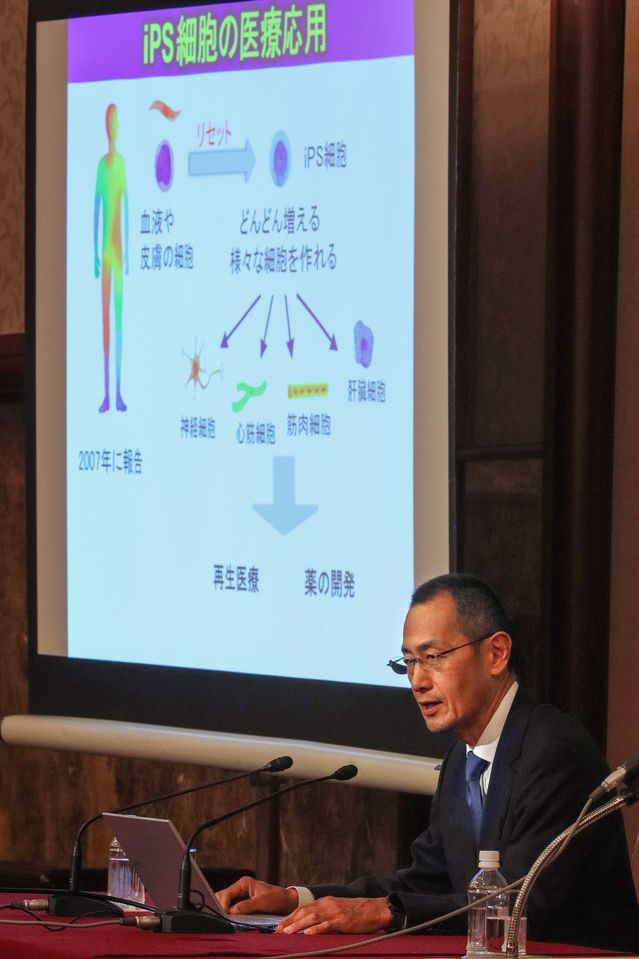
Nobel Prize winner Shinya Yamanaka, here in Tokyo in 2019, made a breakthrough in reprogramming cells. PHOTO: YOSHIO TSUNODA/ZUMA PRESS
“If we can turn the clock back so cells are healthy and resilient, you can reverse disease,” Klausner says.
But there’s limited evidence cellular rejuvenation can be done safely or that it can be an effective way to combat disease or reverse the effects of aging. Some scientists are downright dismissive of the idea. Dr. Richard A. Miller, a professor of pathology at the University of Michigan, who says he hasn’t followed Altos’s efforts, argues that it’s simplistic and misguided to explain illness as the result of cells getting older. In any aging body, cells divide, die, are replaced and change, he notes. So it’s unclear if reprogramming cells can ward off sickness, even if it could be done successfully and safely, he says.
“Aging is something that happens to bodies, not to cells,” Miller says. “The reprogramming idea seems to be a shortcut to try to make cells ‘younger’ in the hopes that this will somehow fix everything. There’s no evidence this will work.”
Others say the approach has both potential and enormous risk.
“Reprogramming technology is powerful, and it works in cells, but when you do it in animals it’s more of a challenge, so an actual product or therapy will be tough,” says Paul Knoepfler, a stem-cell researcher at the University of California, Davis. “You can get cells to be younger but if you get it just a little wrong you can create tumors. There’s not much room for error.”
While Yamanaka’s earlier work demonstrates that “cellular reprogramming can reverse the oldness or agedness of cells to take them back to a youthful cellular state in the form of iPS cells,” that work was done in cells in a Petri dish in a lab, Knoepfler says. “It’s much less clear,” he says, if Altos or others can safely reverse the aging of cells and tissues in a person.
Nelsen and Altos are raiding academic institutions and other organizations to hire nearly 500 scientists around the globe, including several Nobel Prize winners.
“It’s an all-star team of scientists,” Knoepfler says. “They have the freedom to pursue questions, the money makes a difference, they can take more risks…If anyone can do it, they can.”
Nelsen’s track record suggests Altos has a shot at success. His firm has backed successful biotechs including Juno Therapeutics, Illumina, Alnylam and Agios. Industry publication STAT recently named Arch the most successful biotech venture-capital firm of the past year.
Nelsen says he was convinced to bet on Altos by “the breadth of different animal models” demonstrating cell rejuvenation, the quality of the scientists joining the company and the goal of “reversing, not treating disease.”
“My goal is not to make a trillion-dollar company,” he says. “It’s to profoundly restructure a reactive broken industry into a curative industry that has profound impact on humans.”
Anyone know what the brand of electric suit is that he’s using? Perhaps the Katalyst Suit?
Electrical Muscle Stimulation (E-Stim) – A Game-Changer in Workouts?
Key takeaways:
-
Electrical muscle stimulation, otherwise known as e-stem or electroshock therapy for muscles, is a well-established therapy that has historically been used for pain management and mobility. Now, the use of EMS suits can make your workout more challenging and, thus, more effective.
-
EMS works by sending low-frequency electrical impulses to your muscles, causing them to contract. This makes EMS workouts a viable way to increase the efficiency of your workout in less time.
-
Does EMS work? The evidence suggests that it does if you’re pairing it with the right exercise routines, but it’s important to use them under the supervision of a trained individual to ensure both their safety and efficacy.
https://healthnews.com/fitness/physical-health/e-stim-workouts/
Just adding Peter Diamandis to this list of people in the health / longevity field taking rapamycin: Peter Diamandis Longevity Protocol: Weekly 6mg Rapamycin + 100 mg Doxycycline
Also looking at his pills you can see 2g of Omega-3 and about 5-10,000 IUs of vitamin D3.
It’d be nice if he could release his stack so we could mimic/improve upon it. Anyone have his contact info?
I think I would get along well with this guy.
And @Krister_Kauppi 's list of men and women in the health and longevity field who are taking rapamycin:
The biochemist @RyanSmithEpiAge, who is founder of the epigenetic aging testing company TruDiagnostics, has recently revealed that he is taking 6 mg of Rapamycin once every week. So now the male edition of the list contains 18 longevity leaders. If I have missed someone please let me know! Next week I will publish an updated list of the female edition and add some more females to that list.
Observational Study of the Effect of Rapamycin on Facial Aging Among Longevity Experts Using Facial Age Detection
Abstract
This study evaluates the efficacy of rapamycin on facial aging by comparing facial age detection outcomes to actual ages in two groups of longevity experts. We employed the FaceApp age detection AI on IOS for facial age assessment. Our aim was to ascertain any noticeable differences in facial aging between those who consume rapamycin and those who don’t. A t-test comparison of the real age and AI-detected age differences yielded a p-value of 0.44, suggesting no significant difference between the groups.
Introduction
Rapamycin, first identified as an antifungal agent, has been acknowledged for its potential in extending lifespan and postponing age-related diseases. Numerous longevity experts have become advocates or users of this drug. The objective of this observational study is to ascertain any noticeable differences in facial aging — a visible marker of biological aging — between rapamycin users and non-users.
Methodology
Facial age was assessed using the FaceApp age detection AI on the IOS platform. Only recent photos were analyzed to maintain accuracy. Subjects’ actual ages were sourced from Google online searches. The difference between detected facial age and actual age was determined for each participant. Stata 18.0 was employed for statistical analysis. A t-test was conducted with a p-value set at < 0.05.
Results
The results are presented as:
A. Taking Rapamycin
| Name | Face Age | Real Age | Difference (Face - Real) |
|---|---|---|---|
| Mikhail Blagosklonny | 68 | 63 | 5 |
| Alan Green | 75 | 77 | -2 |
| Peter Attia | 44 | 50 | -6 |
| Richard A. Miller | 79 | 74 | 5 |
| Nathaniel David | 42 | 55 | -13 |
| Matt Kaeberlein | 46 | 52 | -6 |
| Robert Nelsen | 58 | 60 | -2 |
| Average difference: -2.71 years |
B. Not Taking Rapamycin
| Name | Face Age | Real Age | Difference (Face - Real) |
|---|---|---|---|
| Joan Mannick | 60 | 64 | -4 |
| Steve Austed | 69 | 77 | -8 |
| Dudley Lamming | 43 | 45 | -2 |
| Eileen White | 60 | 68 | -8 |
| Average difference: -5.5 years |
Two-sample t-test with equal variances: Group C (non-users): Mean = -5.5, Std. Dev. = 3 Group R (users): Mean = -2.714, Std. Dev. = 6.4217 Difference (C-R): -2.7857, t = -0.8049, p = 0.4416
Discussion
The average difference between detected facial age and actual age for rapamycin users is -2.71 years. In contrast, for non-users, it’s -5.5 years. This implies that individuals not taking rapamycin appear, on average, younger in facial aging relative to their actual age than those on the drug. However, several considerations need acknowledgment. The FaceApp’s age detection accuracy may not be consistent. Rapamycin users might have updated photos due to confirmation bias among web users. Also, rapamycin users might be more prominent figures, making their photos more recent than those of non-users. Online age data might be unreliable for some individuals, and the duration of rapamycin usage, which was not addressed in this study, might vary. Despite these limitations, the detected difference may fall within the observational study’s margin of error.
Conclusion
There’s a slight observable difference in facial age detection relative to real age between the two groups. However, this isn’t substantial enough to conclusively deduce the anti-aging efficacy of rapamycin among longevity experts. We recommend more comprehensive studies with larger samples and varied aging markers.
As seen with Bryan Johnson, rapamycin which can cause loss of adipose tissue… body fat can make you appear thinner and older. Losing face fat causes a loss of youthful look.
I can see that.
But, Kaeberlein and Attia are killing it in looks for their 50 - 52-ish age.
Since rapamycin is just slowing down aging and not causing age reversal, I don’t think any of these people have been taking it long enough for us to tell if there is an effect.
It would have been nice to have the test pictures of the subjects before they started rapamycin then 2, 5, or 10 years later.
We will have to wait to see if rapamycin has any meaningful effect on the facial age detection test.
The sample size is so small it would be ridiculed if any scientific journal tried to publish these results.
IMO: The test is meaningless at this time. It is an extremely flawed result because we don’t have the before and after facial age detection photos of the rapamycin users.
Agreed. I might run a before rapamycin 3-years ago and current pic and see what I get. Hahaha.
I am constantly told I am looking younger and younger, by colleagues. Who to me look too old.
Great idea to create this mini-paper and evaluation! I love the creative effort, even if the sample size is small.
Hahaha… I tried it myself, just now, in the medical museum where I work.
At 65 years. I have a range of 51 to 59 years. Which is 6-14 years younger. I will take it.
Biological tests GlycanAge and TruMe say I am 47 years to 52. So maybe!
Even my ID badge got rated… 50 to 58 years… so consistent lol.
Here it is!
You sounded like a reviewer of a medical journal.
You are right. The sample is small. It is a mock paper. I was really trying to see if I could pick up any signal of rapamycin effect.
Using facial features for risk stratification is not new. See this paper: Visible Age-Related Signs and Risk of Ischemic Heart Disease in the General Population https://www.ahajournals.org/doi/10.1161/CIRCULATIONAHA.113.001696.
Anectoctally, facial detection age correlates with coronary calcium on CCTA. This is assuming you have the best facial age detection AI in the IOS store.
This is great but fraught with problems. I’m guessing that how people look affects their interest in looking younger (and in taking rapamycin).
“You sounded like a reviewer of a medical journal.” If I don’t someone wants citations. ![]()
Sure, it’s a fun test, but meaningless in my opinion for individuals to gauge the effects of rapamycin without the before and after rapamycin pictures. Maybe there are some we could find and subjectively judge for ourselves. Dr. Green comes to mind. I haven’t looked yet but I will look for pictures of the people before they took rapamycin and subject the pictures to the same photo age test.
As for me, I took the test and it said I look 5 years younger than I am.
I am 82 so I really don’t care if I really only look 77.
Ha. I feel the same. I want to look 25 years younger, or don’t get my hopes up. (I don’t).
